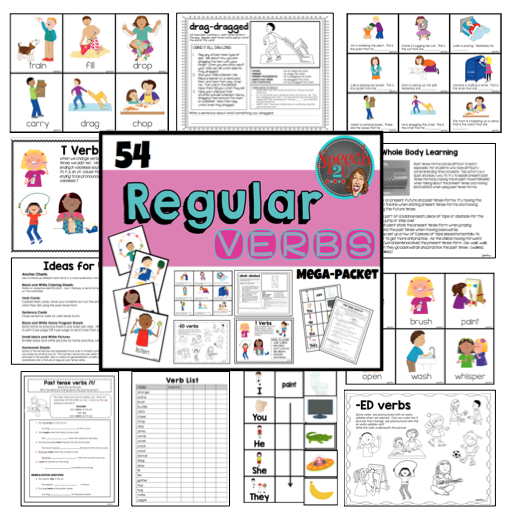Let’s talk about verbs for a bit. Verbs are one of my favorite vocabulary items to teach early communicators. One reason is that verbs can be fun-you can jump, crash, run, spin, burp, sigh, cry or even put things in weird places (like your head).
This is not related at all-but my 6 year old cut his knee bike riding and had a big gash on his knee that he called his crack. He looks at me and asks, “Mom, what if I put something up in my crack? What would happen?” There is a brief moment of mommy panic while I try to figure out if he has, in fact, place some foreign object into his flesh. He takes this opportunity to elaborate, “I mean, what if I stuffed a sandwich up in that crack? I bet my knee would be like, ‘FINALLY, I’ve got a mouth’ This is not how I recommend teaching the word put of course!
One of the things that I’ve always struggled with, is how to organize my teaching-especially when I am thinking about teaching verb tenses. I’ve tried using the Super Duper decks-and targeting 10 until they are learned and then moving on to the next set. I’ve tried using the same set of pictures and playing the typical speech games that I play with card decks. I know I am giving cues-but I wanted to have a more systematic way to teach past tense verb forms. Here are 5 techniques that I use to teach past tense forms:
- Incorporate movement activities: Verbs are fun to learn when you are acting out the verb and then talking about what you did. It’s more fun (and motivating) to learn the word push when I am pushing you on a swing or we are pushing into a wall, then when I am asking you to identify what the 80’s model is doing with that stroller.
- Use direction to teach. I have students practice future tense verbs while walking forward. When they stop, we are using the present tense verb. I have them walk backwards to practice past tense forms. Read about how I use physical movement to teach verb forms HERE.
- Teach using spelling or pronunciation rules: If I am teaching regular tense verbs-I might teach a set of verbs that sound like “t” at the end (ex. biked). I pick my set that I am going to work on and teach them. Now I can check for generalization-are they using that rule with words I haven’t taught in therapy? Next I might move onto to words that sound like a “d” at the end (bagged). I do the same thing with Irregular verb tense forms (I might teach all the verbs that change to an o. It works for my clients because they can start to see the pattern and practice that successfully within a session. Eventually, we work towards combining the different forms to see how they do.
- Incorporate their favorite interests: I use their favorite movies and pick 10-15 verbs that we can use to talk about that movie. For instance, if I have a client who loves Star Wars (first, I’m excited because I love Star Wars) I think about words that we can use for example:
That was pretty geeky. You can impress your students by putting their speech homework on the Star Wars crawl creator HERE.
I’m excited to have a Back to School Verbs Freebie that you can teach to your students.
This packet includes 3 regular and irregular tense verbs. Each verb is taught using flash cards, cloze sentence techniques, fill in the blank sentences and identification worksheets and activity sheets. Click on the above picture to get your freebie. If you like that product, you should definitely check out my regular and irregular verb packets. They contain over 50 verbs to teach each systematically and include charting sheets so that you are only working on verbs that your students haven’t mastered.
I have updated my irregular verb packet by adding an easier to read font, adding 10 new irregular verb targets and updating and doubling the number of verb worksheets in this packet. Both packets will be on sale through September 2, 2015.
I can’t wait to hear what your favorite activities are to address verbs and verb tense forms! If you thought this post was helpful, I’d love it if you would share this with your colleagues by pinning this post or sharing on social media.






